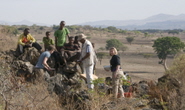Bristol, along with 20 other cities, in 6 different countries, was host to an interesting approach to science communication – over three nights, 19 – 21 May 2014, science took place at the pub!
Although varied, relevant and interesting research takes place every day at Universities, in many cases the general public is completely unaware of what goes on inside them – other than lectures and exams! Pint of Science is a volunteer-based, not-for-profit festival, which takes academic research into the everyday world, by having scientists at the pub sharing their work and answering questions.
Premièring this year in Bristol, the festival was well received, with many of the events sold-out before the doors were even opened. Across the city, four pubs opened their doors to a curious audience looking to learn about a range of topics from nanotechnology, to energy, to the brain and oceans or volcanoes.
Engaging society being at the heart of the Cabot Institute’s aims, it was quick to become involved when approached. As well as sponsoring the event, the Institute was well represented by two of its members, Professors David Fermín and Paul Weaver, who shared their research during the festival.
Energy, Materials and the Electrochemist Dream
 |
| L-R David Parker and David Fermin |
Prof David Fermín and one of his PhD students, Mr David Parker, took on the second evening of the festival, talking about “Energy, Materials and the Electrochemist Dream”. During this event renewable energy sources, in particular solar, were championed. Of interest was the many ways in which solar energy can be harvested and used, whether to be directly converted into electricity or used to produce “solar fuels” from water or carbon dioxide. The need for developing new photovoltaic materials, which are cheap, efficient and made from abundant elements, was stressed. Questions from the public revolved about “how green” these technologies really are and the need to develop a “complete, systematic” approach to energy, which can incorporate various forms and sources of energy. This last is another key interest of the Institute, with groups in Bristol doing interesting work in this area.
Morphing cars, planes and wind turbines: the shape of things to come
 |
| Paul Weaver talks to the pub-goers |
On the festival’s last evening, Prof Paul Weaver and one of his PhD students, Eric Eckstein, talked about “Morphing cars, planes and wind turbines: the shape of things to come”. They discussed the development of new composite materials with the ability to tailor structural properties and the difficulties involved in predicting responses. Also highlighted was the very important interaction and synergy between University and Industry in this field. In a particularly interactive approach they brought along many of the composite materials they work with, alongside demonstrating the strength and failure of various materials, allowing the public to see and feel how different properties can be altered. The use of composite materials in wind turbines and helicopter blades was of particular interest and generated an animated discussion on the subject.


.jpg/800px-Gas_well_(5910119972).jpg)








